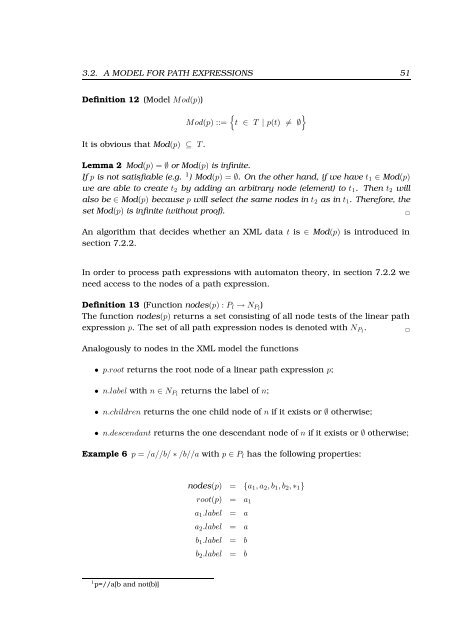url - Universität zu Lübeck
url - Universität zu Lübeck
url - Universität zu Lübeck
You also want an ePaper? Increase the reach of your titles
YUMPU automatically turns print PDFs into web optimized ePapers that Google loves.
3.2. A MODEL FOR PATH EXPRESSIONS 51<br />
Definition 12 (Model Mod(p))<br />
It is obvious that Mod(p) ⊆ T .<br />
Mod(p) ::=<br />
{<br />
}<br />
t ∈ T | p(t) ≠ ∅<br />
Lemma 2 Mod(p) = ∅ or Mod(p) is infinite.<br />
If p is not satisfiable (e.g. 1 ) Mod(p) = ∅. On the other hand, if we have t 1 ∈ Mod(p)<br />
we are able to create t 2 by adding an arbitrary node (element) to t 1 . Then t 2 will<br />
also be ∈ Mod(p) because p will select the same nodes in t 2 as in t 1 . Therefore, the<br />
set Mod(p) is infinite (without proof).<br />
<br />
An algorithm that decides whether an XML data t is ∈ Mod(p) is introduced in<br />
section 7.2.2.<br />
In order to process path expressions with automaton theory, in section 7.2.2 we<br />
need access to the nodes of a path expression.<br />
Definition 13 (Function nodes(p) : P l → N Pl )<br />
The function nodes(p) returns a set consisting of all node tests of the linear path<br />
expression p. The set of all path expression nodes is denoted with N Pl .<br />
<br />
Analogously to nodes in the XML model the functions<br />
• p.root returns the root node of a linear path expression p;<br />
• n.label with n ∈ N Pl returns the label of n;<br />
• n.children returns the one child node of n if it exists or ∅ otherwise;<br />
• n.descendant returns the one descendant node of n if it exists or ∅ otherwise;<br />
Example 6 p = /a//b/ ∗ /b//a with p ∈ P l has the following properties:<br />
nodes(p) = {a 1 , a 2 , b 1 , b 2 , ∗ 1 }<br />
root(p) = a 1<br />
a 1 .label = a<br />
a 2 .label = a<br />
b 1 .label = b<br />
b 2 .label = b<br />
1 p=//a[b and not(b)]
















